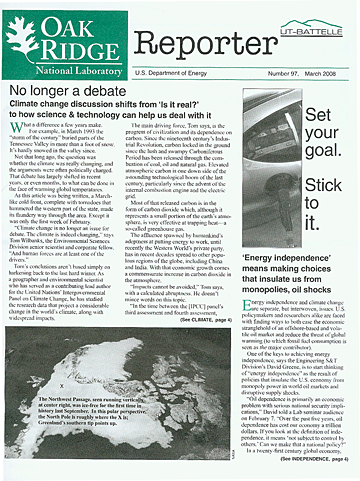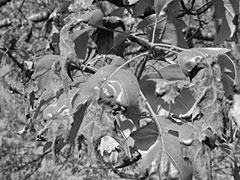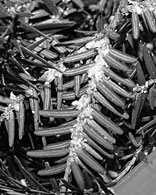 |
Number 97, March 2008 |
 No longer a debate
No longer a debate
Climate change discussion shifts from ‘Is it real?’ to how science & technology can help us deal with it
What a difference a few years make.
For example, in March 1993 the “storm of the century” buried parts of the Tennessee Valley in more than a foot of snow. It’s hardly snowed in the valley since.
|
|
The Northwest Passage, seen running vertically at center right, was ice-free for the first time in history last September. |
Not that long ago, the question was whether the climate was really changing, and the arguments were often politically charged. That debate has largely shifted in recent years, or even months, to what can be done in the face of warming global temperatures.
As this article was being written, a March-like cold front, complete with tornadoes that hammered the western part of the state, made its thundery way through the area. Except it was only the first week of February.
“Climate change is no longer an issue for debate. The climate is indeed changing,” says Tom Wilbanks, the Environmental Sciences Division senior scientist and corporate fellow. “And human forces are at least one of the drivers.”
Tom’s conclusions aren’t based simply on harkening back to the last hard winter. As a geographer and environmental scientist who has served as a contributing lead author for the United Nations’ Intergovernmental Panel on Climate Change, he has studied the research data that project a considerable change in the world’s climate, along with widespread impacts.
The main driving force, Tom says, is the progress of civilization and its dependence on carbon. Since the nineteenth century’s Industrial Revolution, carbon locked in the ground since the lush and swampy Carboniferous Period has been released through the combustion of coal, oil and natural gas. Elevated atmospheric carbon is one down side of the astounding technological boom of the last century, particularly since the advent of the internal combustion engine and the electric grid.
Most of that released carbon is in the form of carbon dioxide which, although it represents a small portion of the earth’s atmosphere, is very effective at trapping heat—a so-called greenhouse gas.
The affluence spawned by humankind’s adeptness at putting energy to work, until recently the Western World’s private party, has in recent decades spread to other populous regions of the globe, including China and India.
With that economic growth comes a commensurate increase in carbon dioxide in the atmosphere.
“Impacts cannot be avoided,” Tom says, with a calculated abruptness. He doesn’t mince words on this topic.
“In the time between the [IPCC] panel’s third assessment and fourth assessment, we’ve seen the impacts emerge much more rapidly than even we had predicted,” he says, “and our ability to adapt to them is questionable in many areas.”
Greenhouse gases, which increased at a rate of 1.3 percent per year in the 1990s, have been racing up at a rate of 3 percent per year during this decade, more than doubling in their rate.
Tom anticipates the next question: Why worry? The sorts of scenarios that former Vice President Al Gore painted in An Inconvenient Truth may lie ahead, he says, with flooded coastlines, parched croplands, altered ecosystems and skewed economies.
|
The argument over whether climate change is in fact real has |
To really hit home, imagine summer heat indexes of 115 degrees on the golf course. If trends continue, duffers won’t have to imagine them for very much longer.
Or you will be able to sail a ship through an ice-free Northwest Passage. For the first time in history. That’s the scale of the change that is under way.
“Business as usual would clearly be catastrophic in many ways,” Tom says.
Arriving at policies toward curbing the emission of carbon into the atmosphere has been shown to be politically and economically difficult. Stabilizing CO2 concentrations in the lower bounds of what is desirable—say, 550 parts per million or less—now appears to be unachievable. A level of 650 to 850 ppm is more likely, which would cause “catastrophic impacts in some areas.”
The argument over whether climate change is in fact real has segued into the debate over what it all means and how, or if, societies and economies can adapt to the changes.
Tom was coordinating lead author for one of the U.S. Climate Change Program’s recently published synthesis and assessment products, which for the first time analyzed the effects climate change will have on U.S. energy production and use. The conclusions range from the common-sensical (less energy spent on heating, more spent on cooling) to the more indirect effects, such as how warmer air and water temperatures could make power plants less efficient and how water scarcity could add to the cooling
challenge.
On the other hand, the growing consumption that is stoking atmospheric CO2 is also driving energy prices higher, which could help inspire R&D in energy technologies that would reduce carbon emissions. That should be happening sooner rather than later.
“The institutions in this country have both the financial power and human resources to respond. There is time to adapt if we take the risks and vulnerabilities seriously in the long run,” Tom says.
But “the world’s climate in 2080 depends on emissions in 2030. Technology needs to be developed now; we’ve got to move fast if we are going to have the breakthroughs that can make a difference by the end of the century,” he says.
The senior corporate fellow’s stance on the topic of climate change has raced past the debate stage, just as the winds of public opinion have shifted enough to acknowledge the urgency of the matter.
“The time to act is now,” he says.—B.C. ![]()
 Set your goal.
Stick
to
it.
Set your goal.
Stick
to
it.
‘Energy independence’ means making choices that insulate us from monopolies, oil shocks
 |
Energy independence and climate change are separate, but interwoven, issues. U.S. policymakers and researchers alike are faced with finding ways to both ease the economic stranglehold of an offshore-based and volatile oil market and reduce the threat of global warming (to which fossil fuel consumption is seen as the major contributor).
One of the keys to achieving energy independence, says the Engineering S&T Division’s David Greene, is to start thinking of “energy independence” as the result of policies that insulate the U.S. economy from monopoly power in world oil markets and disruptive supply shocks.
“Oil dependence is primarily an economic problem with serious national security implications,” David told a Lab seminar audience on February 7. “Over the past five years, oil dependence has cost our economy a trillion dollars. If you look at the definition of independence, it means ‘not subject to control by others.’ Can we make that a national policy?”
In a twenty-first century global economy, the notion of a United States as an energy self-sufficient island is untenable. U.S. oil production topped out in 1970, on the eve of the first energy crisis. Demand for oil—both domestic and international—never stopped growing. Add to that the emergence of the OPEC cartel and nationalized oil companies in countries like Russia and you get an enormous potential to manipulate the supply—and thus the price—of oil.
 |
David Greene |
The result is a volatile market and vulnerable oil consumers. But eliminating oil use or even oil imports is not necessary to solve the problem, David says.
For one thing, cartels have their own vulnerabilities. “Cartels such as OPEC are able to drive up prices in the short run, but they haven’t been able to sustain them indefinitely because the market adjusts to bring prices back down,” David says.
He points to the low oil prices of the 1990s as an example of relative energy independence. That “era of good feeling” came partly as a result of government policies like fuel economy standards but also technological advances in oil drilling that increased supply in the face of OPEC’s production cutbacks. When new supplies such as Alaska’s Prudhoe Bay and the North Sea producers jumped into the breach, prices stabilized, then practically bottomed out.
|
Eliminating oil use or even oil imports is not necessary to solve the energy independence problem. |
The United States could achieve similar energy independence, David says, by implementing similar policies and developing new technologies that increase energy efficiency in transportation and move the transportation sector away from oil—such as plug-in hybrids and biofuels. Sectors like industry and home heating—which in the Northeast still uses substantial amounts of oil—can do their part.
The goal is to insulate the economy from monopoly power and price shocks so that the effect on the economy is less than one percent of the gross national product under almost any eventuality. To accomplish this by 2030 would not require getting off oil or eliminating oil imports. Reducing U.S. oil demand and increasing U.S. liquid fuel supplies by about one third each would be sufficient, according to an analysis by David and Paul Leiby of the Environmental Sciences Division. Their analysis is available on Sen. Richard Lugar’s Energy Initiative web site,
lugar.senate.gov/energy/.
But the cure also represents a Catch-22: As cartels lose market share, they drop their prices, which ultimately lures the market back to the status quo. Then the volatility—and carbon emissions—resume, business as usual.
Unless, of course, the United States—policymakers and people—have the resolve to get the petroleum monkey off their backs and stanch the flow of wealth to oil-producing nations.
“We have to form a policy, and stick to it,” David says. “The best way to do this is to commit to avoiding dangerous climate change. Stabilizing the global climate will also solve our oil dependence problem, and climate change is a problem that is not likely to go away soon.”—B.C. ![]()
 Thompson to head University Partnerships
Thompson to head University Partnerships
 |
Thompson |
Blake Thompson, deputy staff director of the United States Senate Committee on Appropriations, has been selected as ORNL’s director of University Partnerships.
Blake served as principal advisor to Sen. Thad Cochran of Mississippi, the ranking member of the committee responsible for more than $850 billion in federal expenditures. His role included coordination among the Office of Management and Budget and the Senate and House leadership on the funding of federal departments and agencies.
Blake received his Ph.D. from the University of Mississippi, where he also was awarded Bachelor and master of science degrees in pharmaceutical sciences. He holds an executive master’s degree from the Georgetown University School of Business.
Thompson’s role with the Mississippi delegation brought him on a number of occasions to ORNL as the Laboratory developed a variety of research relationships with Mississippi State University, as well as other Mississippi universities and communities. His duties at ORNL will include further development of the Laboratory’s university research partnerships. ![]()
 Paula Flowers leads Independent Oversight
Paula Flowers leads Independent Oversight
 |
Flowers |
Paula Flowers, former commissioner of the Tennessee Department of Commerce and Insurance, has been selected as ORNL manager of Independent Oversight.
Paula served from 2003 to 2007 as commissioner of Commerce and Insurance for Gov. Phil Bredesen. She administered revenues of more than $400 million. Her responsibilities included the regulation of the insurance industry, the securities industry and the array of boards that govern the state’s licensed professionals. She also served as the state fire marshal.
A native of Monterey, Tenn., Paula previously worked as an attorney and an environmental compliance engineer at Y-12. She holds a bachelor’s degree in civil engineering from Tennessee Tech, a master’s degree in civil engineering from McNeese State University, and a law degree from the University of Tennessee, where she graduated Summa Cum Laude.
Paula was a member of Gov. Bredesen’s cabinet during a period when the state of Tennessee expanded the relationship with ORNL, particularly through a closer partnership with the University of Tennessee. At ORNL her duties will include coordination of ORNL’s risk management program and review of operational systems. ![]()
 Chris Griffin joins CSED as latest Wigner Fellow
Chris Griffin joins CSED as latest Wigner Fellow
 |
Griffin |
Chris Griffin has joined the Computational
Sciences & Engineering Division as the Lab’s newest Wigner Fellow. He is working with Rick Sheldon.
Chris received his master’s degree in 2004 in mathematics and his doctorate in 2007 in industrial engineering and operations research from Pennsylvania State University. Before joining ORNL, Chris worked at the Penn State Applied Research Laboratory.
Chris’ current research interests include statistical learning, particularly when applied to problems of learning adversarial strategy. He is currently funded by the Office of Naval Research for work in this area. Chris is also working on a program of analysis of flows in random structures and control problems that result in these systems.
Outside of work, Chris enjoys exercising regularly and taking walks with his wife, Amy, and beagle, Phoebe. ![]()
 Tobin, Green
lead pair of
new divisions
Tobin, Green
lead pair of
new divisions
 |
Tobin |
Two new ORNL divisions, carved from the former Engineering Science & Technology Division, have new directors, as well.
Kenneth W. Tobin Jr. has been named director for the new Electronics, Sensors and Controls Division, effective March 1. Ken has been leader of the Image Science & Machine Vision group since 1991 and more recently the interim leader of the Photonics group in the Engineering S&T Division.
ESCD focuses on measurement science associated with electronics, sensors, signals, patterns and information.
Ken, who joined ORNL in 1987, received his Ph.D. in nuclear engineering from the University of Virginia. He also holds a M.S. degree in Nuclear Engineering and a B.S. in physics from the Virginia Polytechnic Institute and State University. Ken was named an ORNL Corporate Fellow in 2003.
 |
Green |
Johney Boyd Green Jr. has been named director for the new Energy & Transportation Science Division also effective March 1. Johney has led the Fuels, Engines & Emissions Research group since 2003 in the Engineering S&T Division.
ETSD will undertake research and development for a variety of energy and transportation research missions in the areas of building and industrial energy efficiency, electrical power research, fuels, engine and vehicle research and transportation analysis.
Johney joined ORNL in 1995. He received his M.S. and Ph.D. degrees in mechanical engineering from the Georgia Institute of Technology in 1993 and 2000. He also holds a B.S. in mechanical engineering from the University of Memphis. In 2002 Johney completed a year-long assignment at DOE in Washington as the coordinator for the 21st Century Truck Partnership.
Ken and Johney report to Energy & Engineering Sciences Associate Laboratory Director Dana Christensen. ![]()
 |
 For Guinness’ sake
For Guinness’ sake
The Spallation Neutron Source is nowhere near full power, but it’s in the record books. The Guinness Book of World Records accepted ORNL’s claim as home of the world’s most powerful pulsed neutron source.
The record was previously help by ISIS, the pulsed neutron source at England’s Rutherford Appleton Laboratory. Neutron Sciences Associate Lab Director Ian Anderson says the SNS probably broke the neutron record back in August when the SNS set the beam power record. When power was ramped up to 300 kilowatts, it was a done deal.
The Neutron Facilities Development Division’s Phil Ferguson provided the convincing Monte Carlo calculations that convinced the brewer that the SNS set the mark.
“The reason for calculating the number of fast neutrons produced instead of measuring the quantity is because the measurement is difficult for fast neutrons at an operating facility and typically results in large uncertainties,” Phil wrote on the application.
Accepting that, Guinness representative Kaoru Ishikawa e-mailed the news to ORNL Research Library’s Della Elliott, who coordinated the application.
According to Ishikawa, the record will state: “The Spallation Neutron Source at the Oak Ridge National Laboratory (USA) is the most powerful of its kind in the world. By using a proton beam to pound a mercury target with more than 300 kilowatts of energy, it is able to produce 4.8x1016 [48 quadrillion] neutrons per second. These neutrons will eventually be focussed into beams that will allow the molecular analysis of advanced materials.”
 Genome collaborations mushroom
Genome collaborations mushroom
ORNL’s collaborations with DOE’s Joint Genome Institute, located in Walnut Creek, Calif., continue. The JGI-led genome analysis of the symbiotic fungus Laccaria bicolor was published in Nature early this month. The Environmental Sciences Division’s Jerry Tuskan helped lead the international effort that included ORNL and a host of institutions from the United States, France, Belgium, Sweden and Germany.
The interest in Laccaria stems from the mutual and beneficial relationship the mushroom has developed with certain trees. The tree roots incorporate the fungus, which through the development of mycorrhizal roots help provide scarce nutrients to the tree while the tree gives the fungus a safe harbor.
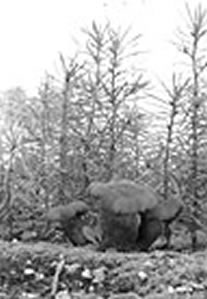 |
Laccaria mushrooms in situ, among fir sprouts. |
Understanding Laccaria’s genome can provide insights into developing plants that store carbon more efficiently or even clean up environmental contaminants.
The symbiosis is vital to plant ecology. “Forests around the world rely on the partnership between plant roots and soil fungi and the environment they create—the rhizosphere,” says JGI Director Eddy Rubin.
Laccaria bicolor occurs frequently in the birch, fir and pine forests of North America, as well as Populus, the promising biofeedstock whose genome was sequenced in 2006. Jerry Tuskan led that project.
“DOE JGI’s expanding portfolio of community genomes provides the researchers with a set of resources that can be used to map out the processes by which fungi colonize wood and soil litter,” Jerry says, adding that the role of the fungi is “fundamental to sustainable plant growth.”
On this project, the ESD players “co-wrote the proposal, organized the effort, developed the genetic map and wrote parts of the final paper,” Jerry says.
 ACS touts Lab’s radioisotope role
ACS touts Lab’s radioisotope role
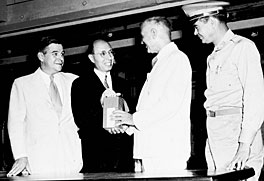 |
They must have known: All were smiling in August 1946 when ORNL science director Eugene Wigner (dark suit) handed over the first shipment of radioisotopes for medical use. |
The physicists got most of the glory from the Manhattan Project, but the chemists’ role was just as important in both winning World War II and developing the field of radiochemistry. That’s especially true of the war’s aftermath and the birth of nuclear medicine.
The American Chemical Society recognized ORNL’s role in one of the earliest, and most valuable, applications of atom splitting to peacetime uses by designating the Lab as a National Historic Nuclear Landmark on March 6.
Almost a year after the first A-bomb was dropped, Eugene Wigner handed over the first shipment of radioisotopes for medical uses, the result of the labors of Lab chemists of the era led by Waldo Cohn. The late Alvin Weinberg would say that medical radioisotopes may have been the crowning achievement of the Graphite Reactor, which produced them.
Those who took the tour to the reactor museum got a bonus: John Gillette was also on the bus. John, a Manhattan Project veteran who was present on the 1943 morning the reactor first reached criticality, described the workings of the reactor and shared a few anecdotes about the earliest days of the atomic age. The event, in fact, drew a number of ORNL veterans back to the Lab.
The East Tennessee Chapter of the ACS helped sponsor the event and the Landmark designation.
“This makes ORNL a site of distinction, for contributions that reach far beyond the boundaries of scientific circles, touching many lives over many decades,” said Judy Benham, chair of the ACS board of directors.
Deputy Director for Science & Technology Jim Roberto noted another, particuarly relevant, aspect of the radioisotope program: “It is one of the greatest technology transfer programs of the national laboratory system.”
—Reported by Bill Cabage |
 ‘Got so hot I froze to death’
‘Got so hot I froze to death’
Easter freeze of 2007 illustrates a cruel paradox of climate change
On a fine Saturday in March 2007, Mac Post was leading a gaggle of Boy Scout leaders-in-training along a trail at Camp Pellissippi, located on Norris Lake in Anderson County.
Mac, an Environmental Sciences Division researcher, pointed out the different types of flora and fauna common in the woods—the fiddlehead ferns, the centipedes and millipedes and the new sprouts of poison ivy emerging from fuzzy vines. Although it had just turned spring on the calendar, several weeks of balmy weather had already signaled the plants to start producing.
That night, rain rolled in, driving the Sunday portion of “outdoor training” indoors. By the next Friday—Good Friday—it was spitting snow and nipping houseplants that had been set outside to enjoy the warm sunshine. Over the next few days, nighttime temperatures dropped into the twenties.
A frost-bitten oak showed the damage to leaves weeks after the April 2007 freeze. Many trees species didn’t fully recover, and some may be affected by the freeze damage this season. |
|
The destructive Easter freeze that chilled the eastern United States a year ago illustrates one threat a warming climate poses to plants and crops, according to an article just published in the journal BioScience. The study was led by an ESD team joined by researchers from NASA’s Ames Research Center, the National Oceanic and Atmospheric Administration.
The “Easter freeze” of April 5-9, 2007, blew in on an ill wind. Plants had been sending out young and tender sprouts two to three weeks earlier than normal during an unusually warm March. Plant ecologists, as well as farmers and gardeners, took note of the particularly harsh turn of the weather in early April.
“The warm weather was as much a culprit for the damage as the cold,” says the lead author, ESD’s Lianhong Gu.
“We see the paradox in that mild winters and warm, early springs make the plants particularly vulnerable to late-season frosts,” Lianhong says.
Lianhong’s team observed satellite images and field data to establish the extent of the 2007 spring freeze. They also assessed the long-term and short-term effects on the terrestrial carbon cycle with respect to plant activity in normal years. Short-term effects were “profound,” Lianhong says.
“In the period just after the freeze we saw a large reduction in the fraction of absorbed photosynthetically active radiation, which is a sensitive indicator of plant growth,” he says. “We also noted that the regrowth in the following weeks and months did not result in the levels of plant development in previous years.”
Lianhong’s team hypothesized that the freeze could have long-term effects on forest carbon uptake because of damage the cold did to the prematurely developed plant tissues, which could affect future growing seasons. The associated carbon and nutrient losses may affect growth in future years.
Beyond devastated horticultural crops, the study noted that some species suffered more than others. Green and succulent fields of switchgrass at an agricultural experiment station in Milan, Tenn., were frozen back to a winter brown, but recovered quickly. On the other hand, yellow poplar trees were “surprisingly” slow to put out flushes of new leaves, and white oaks were particularly hard hit with freeze damage to both new leaves and flowers.
Interestingly, trees located along shorelines—where the water stores heat—and underneath dense canopies seemed to be
protected from the cold.
Compounding the stress on plants, as noted in the International Panel on Climate Change’s fourth assessment report, is the prospect of prolonged droughts, which also occurred in the region last summer.
“This freeze should not be viewed as an isolated event; rather, it represents a realistic climate change scenario that has long concerned plant ecologists,” Lianhong says.
Authors on the paper include Lianhong, Paul Hanson, Dale Kaiser, Mac Post and Bai Yang of ORNL; Ramakrishna Nemani of NASA’s Ames Research Center; Stephen G. Pallardy of the University of Missouri at Columbia; and Tilden Meyers of the National Oceanic and Atmospheric Administration’s Air Resources Laboratory in Oak Ridge. The DOE Office of Science’s Biological and Environmental Research program funded the study.—B.C.
|
||
|---|---|---|
If you have a hemlock tree, you might have noticed little white spots on the needles. Those are hemlock woolly adelgids, and unless treated they will eventually kill the tree. |
 West side story
West side story
Researchers move into joint institute, refurbished aquatic lab. Coming up, a plaza.
 |
 Looking from the east, the Joint Institute for Biological Sciences (left and inset) will be the centerpiece for the new west campus, which will include a plaza complete with a bridge across First Creek, shown in the foreground. Looking from the east, the Joint Institute for Biological Sciences (left and inset) will be the centerpiece for the new west campus, which will include a plaza complete with a bridge across First Creek, shown in the foreground. |
Following a wave of construction activities, things are coming together on the west end of the Laboratory. Some of the results are obvious; other projects are more subtle. On the whole, by this fall the west side will have undergone a fairly remarkable transformation.
“Things are going to look a lot different over there,” Biological & Environmental Sciences Operations Manager Barry Berven says about the west campus.
The obvious change includes the recently finished Joint Institute for Biological Sciences, the second in the series of four state-funded joint institutes to be completed. While work is still going on around the facility, researchers have been moving into the JIBS labs and offices.
Compared with the Joint Institute for Computational Sciences on the east campus, JIBS has a much more utilitarian design. The
$12 million building features 18 laboratories—six per floor—in the central part of the building with offices located on the outside walls.
The labs are equipped with a centralized exhaust system, which is an efficient setup in terms of both energy efficiency and maintenance (unlike some of the older buildings, in which hoods are separate and thus require their own fans and maintenance) and configured to host state-of-the-art research equipment.
The entrance area is an atrium-styled lobby that will serve as a central services area for the west campus, complete with an ATM machine and a food service area.
Conference rooms are located on the second and third floors. Well equipped in terms of audio visuals, the second-floor conference room also comes with a view overlooking the lobby area.
The joint institute comes on line with a full slate of work to be done. The state of Tennessee has invested in a biofuels enterprise with a focus on enabling research at the University of Tennessee and ORNL. The Energy Department, meanwhile, has located one of its three bioenergy research centers—the BioEnergy Science Center—in JIBS.
 |
The renovated Aquatic Ecology Lab still features the long water races that simulate streams. Barry Berven, researcher Mark Bevelheimer and Biological & Environmental Sciences Associate Lab Director Reinhold Mann are in the background. |
In addition to the $12 million for the construction of the joint institute, the state has also purchased $3 million worth of state-of-the-art equipment for the facility.
Just across the street, the single-story Aquatic Ecology Laboratory in Building 1504 has just completed a renovation that has updated its water-environment simulators and added offices for research staff.
“We added four new offices and several new workstations,” Barry says of the project, which renovated 9,000 of the building’s 10,000 square feet. “We realigned the artificial streams and moved in holding tanks for fish used in our research. This makes the facility much more efficient and adaptable to our research needs.”
The aqua-lab still features the long water races that simulate flowing streams. Projects currently under way include hydropower system studies that study impacts of dams and generating equipment on fish populations, sponsored by DOE and by the Electric Power Research Instittute.
The new and refurbished facilities join the new mouse house—the Russell Laboratory for Comparative and Functional Genomics—completed in 2004 and the renovated greenhouses in Building 1506.
Stitching it all together will be a promenade reminiscent of the east campus’s quad, between JIBS and Building 1505 on one side and the Russell Lab on the other. The walkway will feature a circular plaza and pedestrian bridge across First Creek.
Two more state-funded joint institutes are planned: the Joint Institute for Neutron Sciences, to be located near the Spallation Neutron Source, and the Joint Institute for Advanced Materials, which will be located on the UT campus.—B.C. ![]()
 Protein pairs feel the heat
Protein pairs feel the heat
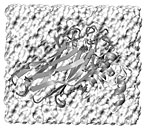 |
Simulations predict the effects of temperature on protein motion. |
Computer simulations have shown that pairs of proteins bound to each other undergo a profound change in their relative motion as they heat up, a phenomenon that could provide clues to how proteins interact to govern living cells.
The molecular dynamics simulations, the product of an international collaboration led by ORNL researcher Jeremy Smith, are currently being pursued on the Cray XT4 Jaguar supercomputer. The simulations set the stage for neutron scattering experiments to test the theory by measuring protein motion.
Jeremy, who leads the ORNL Center for Molecular Biophysics and also holds a University of Tennessee-ORNL Governor’s Chair, collaborated with researchers from the University of Heidelberg in Germany. Their study has been accepted for publication in Physical Review Letters.
“The living cell is a network of proteins that talk to each other by interacting, sometimes transiently, sometimes for long periods of time. These interactions are important at every stage of cell function. Understanding the physical nature of these associations will help us to comprehend why they form and when,” Jeremy says.
The simulations performed by his team followed how a pair of interacting proteins move relative to each other as temperature increases.
Internal motions in proteins and many other materials undergo a rapid softening at a certain temperature, in a phenomenon called the “glass-to-liquid” or simply “glass” transition. The new simulations show that there is also a glass transition in the way the proteins in a pair, or ‘complex,’ move relative to each other.
At very low temperatures, around -200ºC, protein complexes are frozen stiff in a glassy state. But at around -40ºC, they suddenly free themselves up and behave like molecules in a liquid, diffusing randomly relative to each other, all while still remaining in touch, Jeremy says.
“The motion may in the future become measurable using specialized spectrometers at the Spallation Neutron Source, as neutron scattering has historically been a major technique for examining glass transition behavior,” Jeremy says. “Moreover, our team is wasting no time pushing forward with our calculations with a massive, 3.5-million-atom simulation of a thousand interacting proteins running on the ORNL Jaguar Cray XT4 supercomputer, even as the PRL article goes to press.”—B.C. ![]()
 New Staff
Members
New Staff
Members
Xiaolin Cheng, Computer Sci. & Mathematics
Olivier Andre Maxime Gourdon, NScD Neutron Scattering Science
Tina Caldwell Heath, Office of Chief Information Officer (Transfer)
Paul Kardol and David Joseph Weston, Environmental Sciences
Carol Diane Rader, Partnerships Dir.
John Mark Reel and Shane Roger Halverson, NScD Research Accelerator
William Clyde Walker, Nuclear & Radiological Protection
Michael John Dayton and James Gantner Janney, NScD Neutron Facilities Development
Debbie Kay Turner, Legal Dir.
Stephanie Michelle Ritchie, Human Resources Dir.
Edward Joseph Moran IV, NScD Research Reactors
Paul Fredric Becher, Materials S&T
Glenn David Buckley, Integrated Operations Support
David Ernest Clark, Nonreactor Nuclear Facilities
James M. Padgett Jr., Information Technology Services ![]()
 ORNL grade: All A’s
ORNL grade: All A’s
UT-Battelle received a grade of A in the area of science and technology performed at ORNL, part of a “report card” of all A’s and A minuses.
“Receiving ‘straight A’s’ is a rare occurrence in the DOE system and is a statement of the agency’s confidence in your talents and in our ability to manage the Laboratory,” Lab Director Thom Mason said in a message to staff members.
DOE rated UT-Battelle’s performance from October 2006 through September 2007 on eight performance goals that included the quality of research programs and the efficiency of the lab’s operations. The laboratory did not receive a score below A-minus on any of the eight goals.
Grades on the eight performance goals determine UT-Battelle’s fee for operating the Laboratory. UT-Battelle’s total fee for operating ORNL in fiscal year 2007 is $10,379,000, or 97 percent of the maximum fee.
DOE’s award letter noted a number of highlights in 2007. The Spallation Neutron Source set a new world record for the production of neutrons, the Jaguar became one of the world’s most powerful supercomputers and DOE selected ORNL to lead one of the agency’s three new bioenergy research
centers.
The award letter stated that UT-Battelle “notably exceeded expectations” in the category of waste minimization-pollution prevention. The letter also stated that “leadership and stewardship of the Laboratory exceeded expectations, highlighted by commendable performance in community service and significant partnership and teaming efforts.”
 ORNL People
ORNL People
Peter Blau of the Materials Science & Technology Division has been elected a fellow of the Society of Tribologists & Lubrication Engineers, which includes more than 4,000 members involved in friction and wear.
The Biosciences Division’s Tommy J. Phelps has been elected a fellow of the American Academy of Microbiology. The academy’s more than 2,000 fellows represent all subspecialties of microbiology, including basic and applied research, teaching, public health, industry and government service.
The Nuclear S&T Division’s Charles Forsberg has retired to return to his alma mater, the Massachusetts Institute of Technology. Charles, a corporate fellow and one of the country’s foremost nuclear energy experts, will be the executive director of MIT’s Nuclear Fuel Cycle Center.
Slava Danilov of the Research Accelerator Division’s Accelerator Physics group has received one of two accelerator-related prizes awarded by the European Physical Society Accelerator Group every two years. Slava’s EPS-AG Accelerator Prize is “for numerous contributions to accelerator physics,” including a successful laser-stripping experiment.
Bryant (Dell) Morgan is the Facilities Development Division’s new director. Dell has been acting FDD director since Lanny Bates accepted a position with Brookhaven National Laboratory.
The Energy S&T Division’s Diane Davidson has been asked to serve on the National Cooperative Research Program Project Panel 15, “Understanding Urban Good Movements.”
ESTD’s Frank Southworth has been asked to serve on the Transportation Research Board Committee on Travel Survey Methods. The current goals of the committee are to enhance the quality and usefulness of transportation surveys done at the local, state and national levels.
